Get rid of redirects to and from pushmehoney.com
Notification SpamAlso Known As: pushmehoney.com pop-up
Get free scan and check if your device is infected.
Remove it nowTo use full-featured product, you have to purchase a license for Combo Cleaner. Seven days free trial available. Combo Cleaner is owned and operated by RCS LT, the parent company of PCRisk.com.
What is pushmehoney[.]com?
Pushmehoney[.]com is a rogue website, sharing many similarities with rumiceseeds.com, withingadvertly.pro, exclusivenotifications.com and thousands of others. Once entered, it redirects users to other untrustworthy sites or begins feeding users likewise unreliable, even malignant content.
It should be noted that intentional visits to this site are rare. Most visitors get redirecting to it, either by compromised sites (specifically, intrusive advertisements therein) or by PUAs (potentially unwanted applications). Often, these dubious applications are installed without express user permission.
Successfully within a system, they cause unauthorized redirects, deliver aggressive, invasive ad campaigns and gather information.
![pushmehoney[.]com pop-up redirects](/images/stories/screenshots201906/pushmehoneycom-homepage.jpg)
The pushmehoney[.]com site spreads through redirects initiated by intrusive advertisements. Also, by PUAs force-opening new browser tabs/windows and redirecting users to it. Visitor geolocation is key to determining this website's course of action. It learns this data by checking their IP (Internet Protocol) address.
From then on, it redirects users to untrustworthy sites and/or presents them with similarly unreliable/malicious content. Entering pushmehoney[.]com is strongly advised against, as it can lead to various system infections and security issues. It must be mentioned that said rogue website employs browser notifications, which if allowed - begin running invasive ad campaigns.
Advertisements of this type are considered a threat, due to the dubious or outright malicious sites they redirect to. They can also execute scripts designed to autonomously download potentially unwanted applications. As previously stated, PUAs cause redirects, deliver ads and track data.
To elaborate, the sites they redirect to are often highly untrustworthy. The advertisement campaigns unwanted apps run - are displayed through tools that enable third party graphical content. Hence, these adverts can overlay original site content, consequently making the browsing experience abysmal.
Lastly, PUAs can monitor and gather information. By tracking browsing and search engine history, they can infer personal info (IP address, geolocation and user identity details). What is important to know, is that this information is then passed onto third parties (possibly, even cyber criminals) and misused for profit. All PUAs must be removed to ensure device and user safety.
| Name | pushmehoney.com pop-up |
| Threat Type | Push notifications ads, Unwanted ads, Pop-up ads |
| Serving IP Address | 78.140.165.8 |
| Observed Domains | 435rc.pushmehoney[.]com, 4ypwc.pushmehoney[.]com, ap3z2.pushmehoney[.]com, gq3h9.pushmehoney[.]com, kdasz.pushmehoney[.]com, lseff.pushmehoney[.]com, n3tga.pushmehoney[.]com, n5cag.pushmehoney[.]com, qqmp1.pushmehoney[.]com, thtr6.pushmehoney[.]com |
| Symptoms | Seeing advertisements not originating from the sites you are browsing. Intrusive pop-up ads. Decreased Internet browsing speed. |
| Distribution Methods | Deceptive pop-up ads, potentially unwanted applications (adware) |
| Damage | Decreased computer performance, browser tracking - privacy issues, possible additional malware infections. |
| Malware Removal (Windows) |
To eliminate possible malware infections, scan your computer with legitimate antivirus software. Our security researchers recommend using Combo Cleaner. Download Combo CleanerTo use full-featured product, you have to purchase a license for Combo Cleaner. 7 days free trial available. Combo Cleaner is owned and operated by RCS LT, the parent company of PCRisk.com. |
Mostly, PUA developers promote their product by offering a wide range of "useful" features. Additionally, they are designed to appear legitimate and harmless.
However, most promises that such apps make are empty, and listed features turn out to be nonfunctional. It must be stressed, that the only purpose PUAs serve is to generate revenue for their developers. Users gain nothing by having them on their systems.
In fact, victims of unwanted applications can end up with system and browser infections, severe privacy and identity issues (even have their identity stolen).
How did adware install on my computer?
There are two main ways that PUAs invade systems: by intrusive adverts making rogue downloads/installs and by being installed alongside regular software. Users entering untrustworthy sites and clicking invasive ads within - can become victims of undesired apps infiltrating their device.
By using suspect sources for downloading software, downloading bundled programs becomes very likely. "Bundling" is a false marketing method, by which ordinary software is pre-packed with PUAs. An opt-put from any additional apps/features is often possible, however it can be hidden behind "Custom/Advanced" settings.
As the average user tends to move through the installation process quickly - step skipping, usage of pre-set options - becomes habit. This very trait of haste and inattentiveness is often the reason behind rogue application invasions.
How to avoid installation of potentially unwanted applications?
It is highly recommended to use only official and verified sources for all software downloads, preferably through direct download links. P2P (peer-to-peer) sharing networks and other third party downloaders are strongly advised against. Unofficial download sources are much more likely to offer install packs with PUAs present within them.
Recommendations when installing include: thorough inspection of terms and possible options, usage of "Custom/Advanced" settings, opt-outing out from installing/downloading any additional applications/features. Knowledge and caution are essential in order to ensure user safety.
That is why any tempting offers should always be researched, to verify whether they are legitimate. Prudent browsing is also encouraged; cautious approach to suspicious websites and advertisements. Intrusive adverts can often look utterly ordinary, therefore they aren't difficult to fall prey to.
However, the sites they redirect to (pornography, gambling, adult-dating and etc.) - are easier to determine as being untrustworthy. Should users encounter such ads/redirects - immediate removal of all questionable applications and browser extensions/plug-ins is recommended.
If your computer is already infected with rogue applications, we recommend running a scan with Combo Cleaner Antivirus for Windows to automatically eliminate them.
Appearance of pushmehoney[.]com website (GIF):
![pushmehoney[.]com website appearance (GIF)](/images/stories/screenshots201906/pushmehoneycom-appearance.gif)
Instant automatic malware removal:
Manual threat removal might be a lengthy and complicated process that requires advanced IT skills. Combo Cleaner is a professional automatic malware removal tool that is recommended to get rid of malware. Download it by clicking the button below:
DOWNLOAD Combo CleanerBy downloading any software listed on this website you agree to our Privacy Policy and Terms of Use. To use full-featured product, you have to purchase a license for Combo Cleaner. 7 days free trial available. Combo Cleaner is owned and operated by RCS LT, the parent company of PCRisk.com.
Quick menu:
- What is pushmehoney.com pop-up?
- STEP 1. Remove spam notifications from Google Chrome
- STEP 2. Remove spam notifications from Google Chrome (Android)
- STEP 3. Remove spam notifications from Mozilla Firefox
- STEP 4. Remove spam notifications from Microsoft Edge
- STEP 5. Remove spam notifications from Safari (macOS)
Disable unwanted browser notifications:
Video showing how to disable web browser notifications:
 Remove spam notifications from Google Chrome:
Remove spam notifications from Google Chrome:
Click the Menu button (three dots) on the right upper corner of the screen and select "Settings". In the opened window select "Privacy and security", then click on "Site Settings" and choose "Notifications".
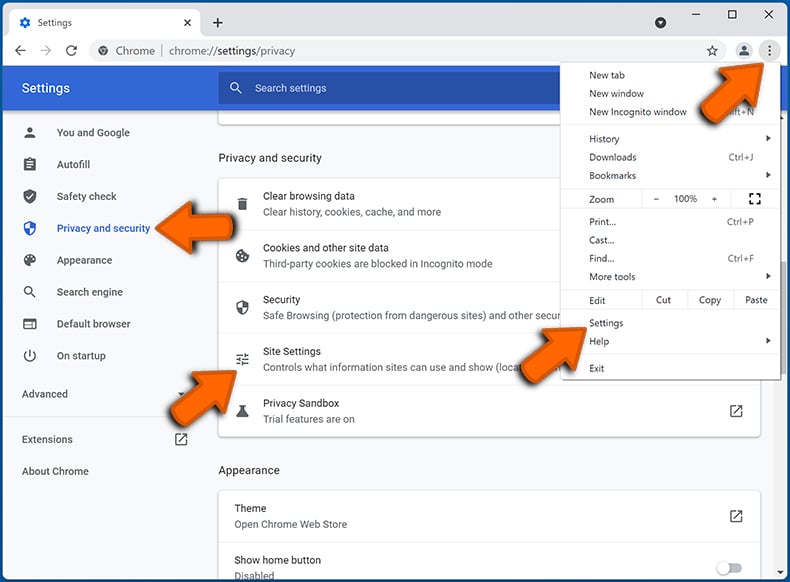
In the "Allowed to send notifications" list search for websites that you want to stop receiving notifications from. Click on the three dots icon near the website URL and click "Block" or "Remove" (if you click "Remove" and visit the malicious site once more, it will ask to enable notifications again).
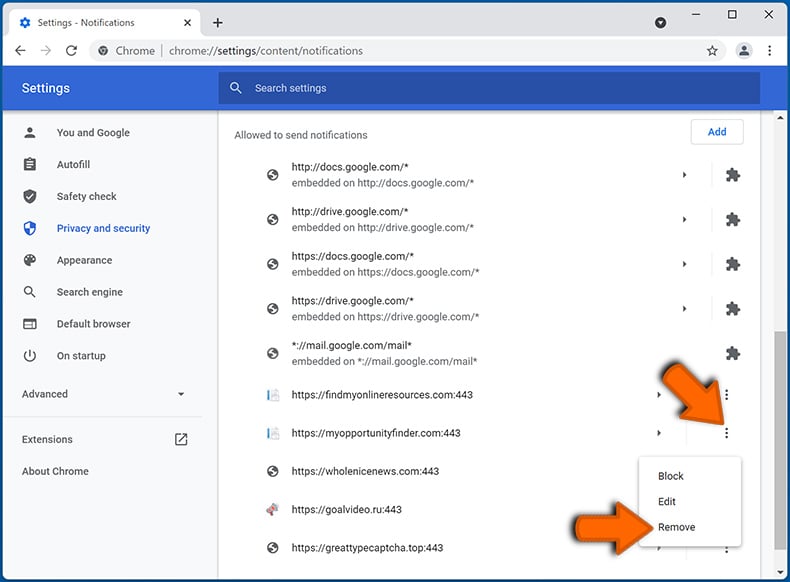
 Remove spam notifications from Google Chrome (Android):
Remove spam notifications from Google Chrome (Android):
Tap the Menu button (three dots) on the right upper corner of the screen and select "Settings". Scroll down, tap on "Site settings" and then "Notifications".
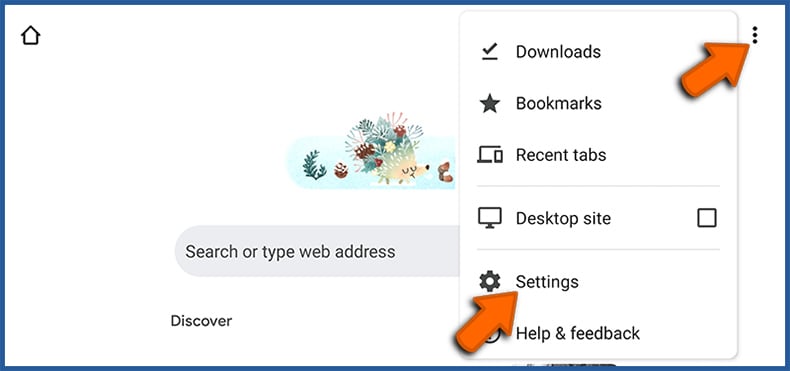
In the opened window, locate all suspicious URLs and tap on them one-by-one. Once the pop-up shows up, select either "Block" or "Remove" (if you tap "Remove" and visit the malicious site once more, it will ask to enable notifications again).
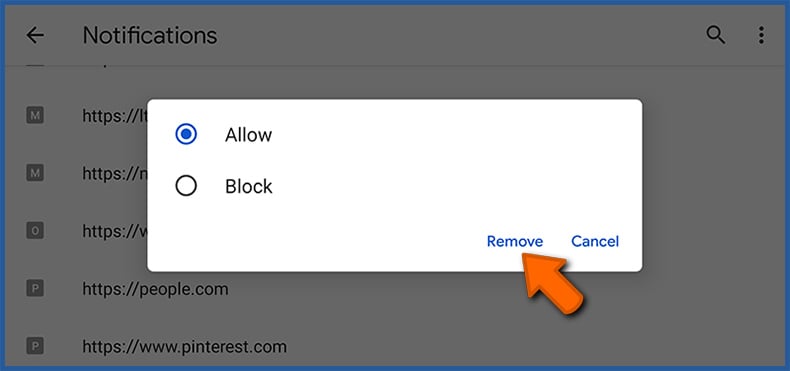
 Remove spam notifications from Mozilla Firefox:
Remove spam notifications from Mozilla Firefox:
Click the Menu button (three bars) on the right upper corner of the screen. Select "Settings" and click on "Privacy & Security" in the toolbar on the left hand side of the screen. Scroll down to the "Permissions" section and click the "Settings" button next to "Notifications".
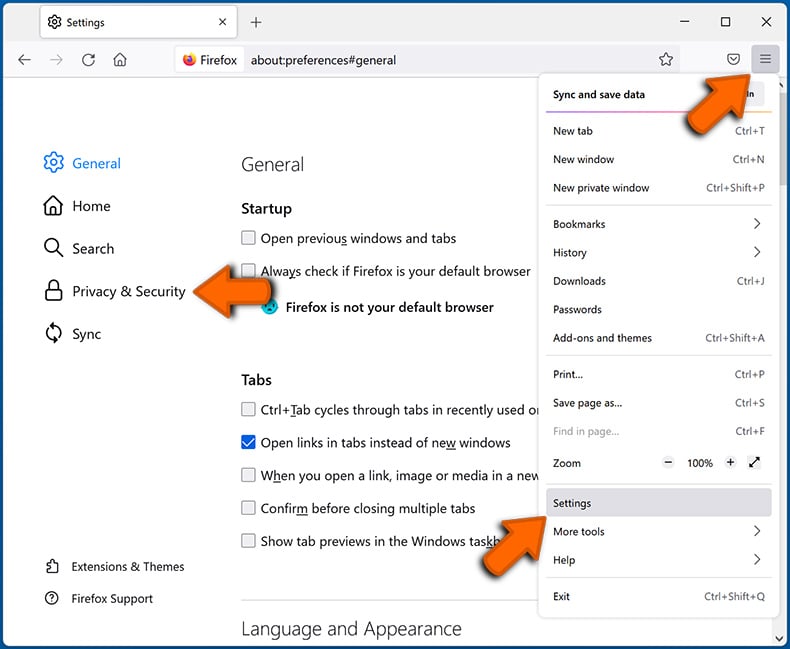
In the opened window, locate all suspicious URLs and block them using the drop-down menu or either remove them by clicking "Remove Website" at the bottom of the window (if you click "Remove Website" and visit the malicious site once more, it will ask to enable notifications again).
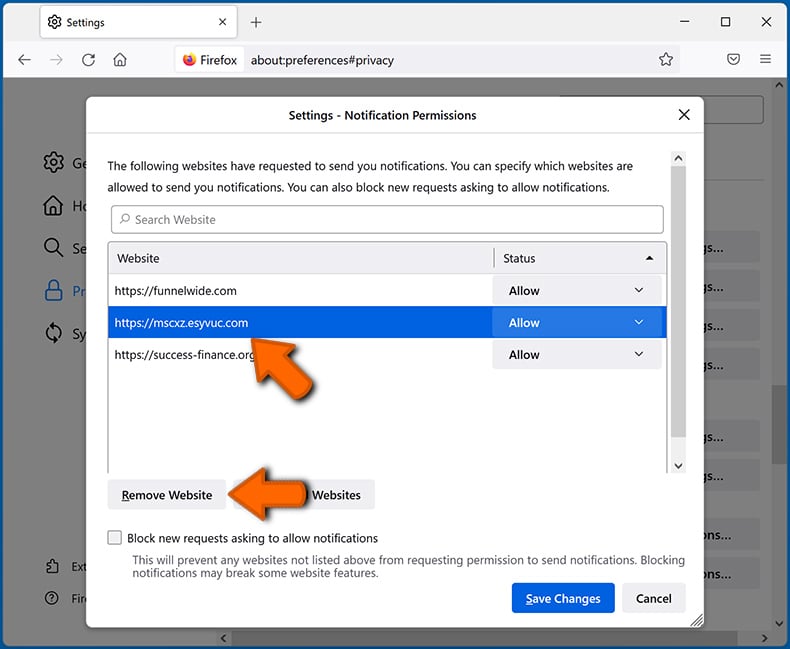
 Remove spam notifications from Microsoft Edge:
Remove spam notifications from Microsoft Edge:
Click the menu button (three dots) on the right upper corner of the Edge window and select "Settings". Click on "Cookies and site permissions" in the toolbar on the left hand side of the screen and select "Notifications".
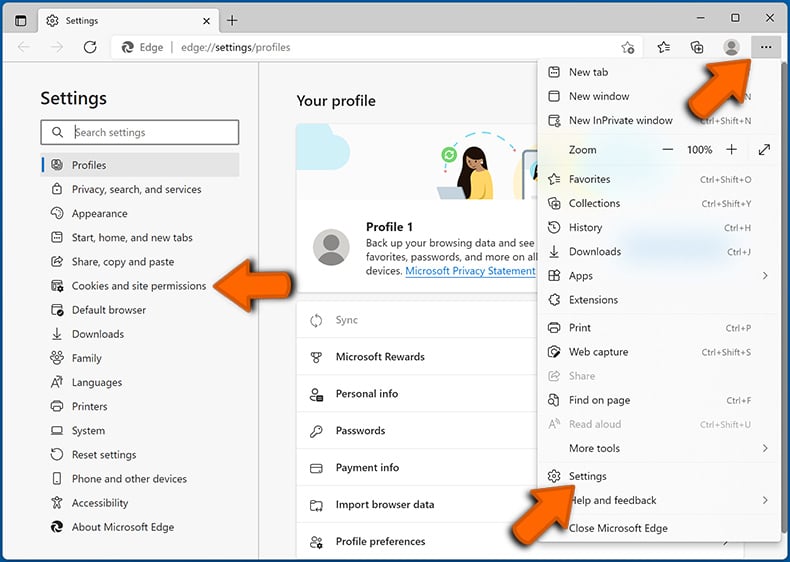
Click three dots on the right hand side of each suspicious URL under "Allow" section and click "Block" or "Remove" (if you click "Remove" and visit the malicious site once more, it will ask to enable notifications again).
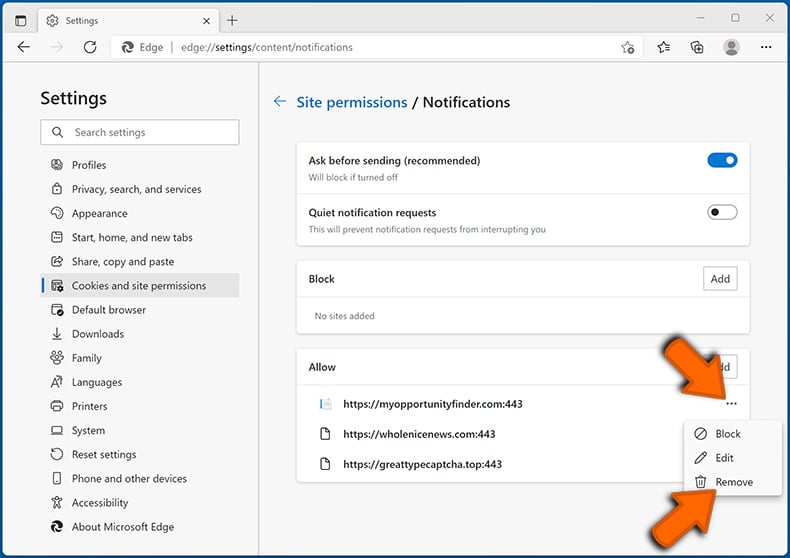
 Remove spam notifications from Safari (macOS):
Remove spam notifications from Safari (macOS):
Click "Safari" button on the left upper corner of the screen and select "Preferences...". Select the "Websites" tab and then select "Notifications" section on the left pane.
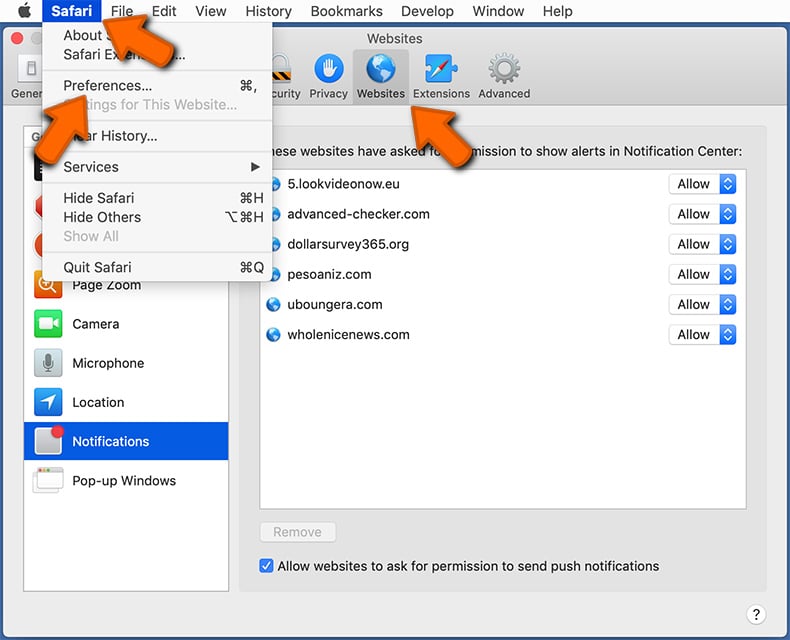
Check for suspicious URLs and apply the "Deny" option using the drop-down menu or either remove them by clicking "Remove" at the bottom of the window (if you click "Remove" and visit the malicious site once more, it will ask to enable notifications again)
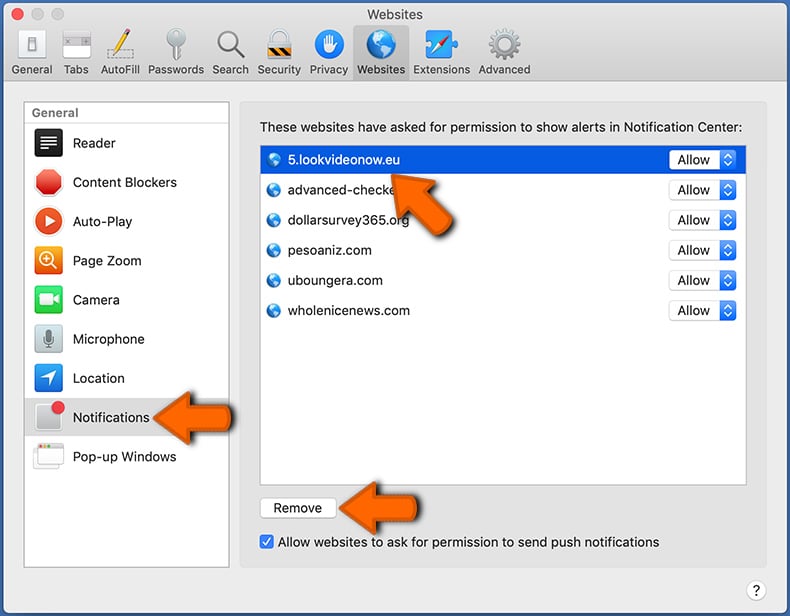
How to avoid browser notification spam?
Internet users should be very skeptical when being asked to allow notifications. While this is a useful feature that allows you to receive timely news from websites you like, deceptive marketers frequently abuse it.
Only allow notifications from websites that you fully trust. For added security - use an anti-malware application with a real-time web browsing monitor to block shady websites that tries to trick you into allowing spam notifications. We recommend using Combo Cleaner Antivirus for Windows.
Share:

Tomas Meskauskas
Expert security researcher, professional malware analyst
I am passionate about computer security and technology. I have an experience of over 10 years working in various companies related to computer technical issue solving and Internet security. I have been working as an author and editor for pcrisk.com since 2010. Follow me on Twitter and LinkedIn to stay informed about the latest online security threats.
PCrisk security portal is brought by a company RCS LT.
Joined forces of security researchers help educate computer users about the latest online security threats. More information about the company RCS LT.
Our malware removal guides are free. However, if you want to support us you can send us a donation.
DonatePCrisk security portal is brought by a company RCS LT.
Joined forces of security researchers help educate computer users about the latest online security threats. More information about the company RCS LT.
Our malware removal guides are free. However, if you want to support us you can send us a donation.
Donate
▼ Show Discussion